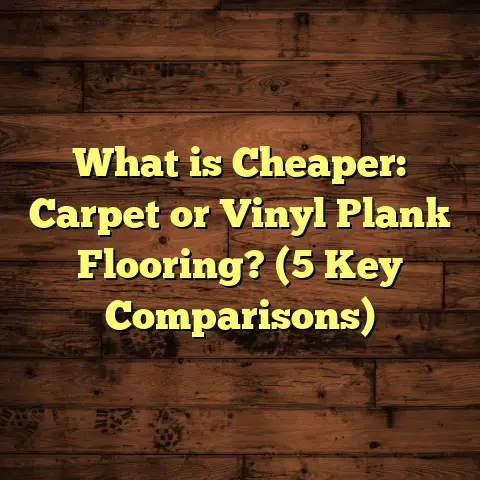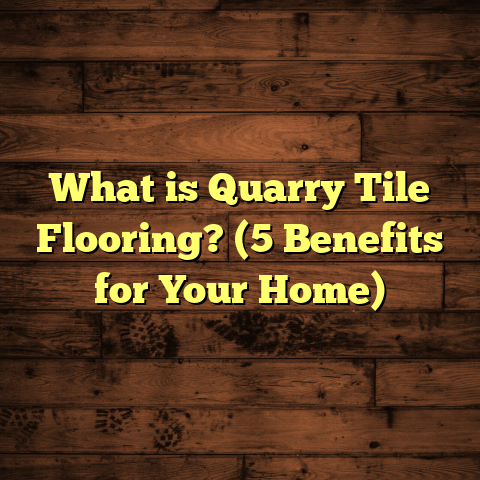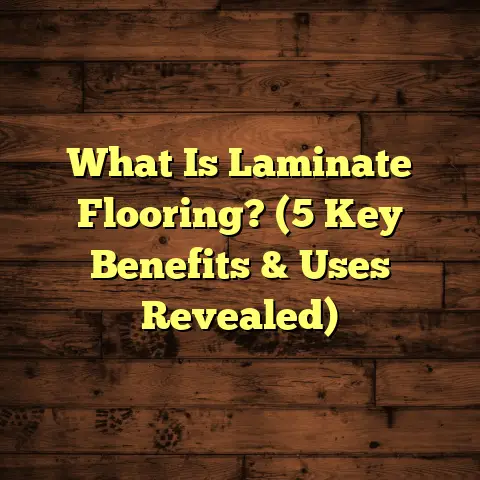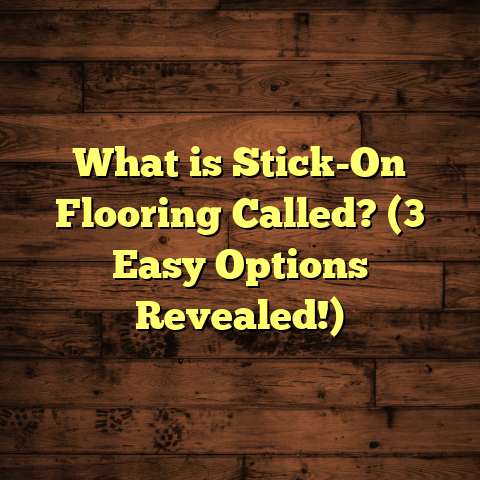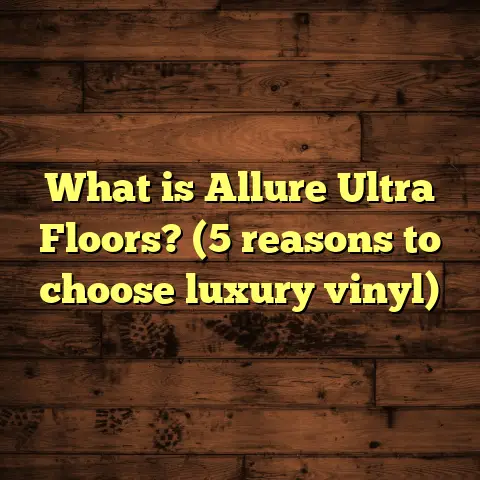What is Cheap Attractive Flooring for Production Space? (5 Smart Options)
Imagine you’ve just taken over a production space—maybe a small factory, a workshop, or a warehouse. You’re excited but facing one big challenge: the flooring. It needs to be affordable, sure, but also tough enough to handle heavy equipment and foot traffic, and attractive enough to keep the place looking professional. So what do you do? How do you pick cheap attractive flooring that fits a production environment without breaking the bank or sacrificing durability?
That’s exactly what I want to talk about today. I’ve worked with all sorts of flooring in production spaces over the years, and I’ve learned what works and what doesn’t through hands-on experience and research. I’ll walk you through five smart options that balance cost, performance, and appearance—so you can make the right choice for your space.
What is Cheap Attractive Flooring for Production Space?
Let’s start by defining what I mean here. When we say “cheap attractive flooring” for production areas, I’m talking about flooring options that:
- Cost less upfront but provide good value over time
- Are durable enough to handle industrial wear and tear
- Look decent enough to reflect positively on your business
- Are easy to maintain and repair if needed
- Fit well with the specific needs of production environments (chemicals, machinery, foot traffic)
Production spaces aren’t like homes or offices where fancy hardwood or plush carpet might be the go-to. They demand floors that stand up to impact, spills, abrasion, and sometimes heavy loads. But that doesn’t mean you have to settle for ugly concrete or super basic vinyl.
The key is balancing price, performance, and appearance. You want something that won’t cost thousands per square foot but still looks clean and professional. And it must hold up under the kind of stress typical in a production setting.
Why Flooring Choices Matter in Production Spaces
I learned this the hard way early on. One client I worked with chose cheap epoxy flooring without researching much. At first, it looked great—smooth, shiny, professional. But within six months, heavy equipment had chipped large sections, and chemical spills faded the color badly. They ended up replacing the whole floor after only a year—doubling their costs.
That experience taught me that picking flooring isn’t just about upfront price or looks. You have to think about:
- Long-term durability
- Resistance to chemicals and wear
- Ease of cleaning and maintenance
- Safety features like slip resistance
- Installation time and disruption
Getting these right means fewer headaches down the road.
How I Approach Flooring Decisions for Production Spaces
Before jumping into specific materials, here’s how I personally approach these projects when I’m called in as a flooring contractor or consultant:
- Assess the Use Case: What kind of production happens here? Is it heavy machinery? Chemicals? Foot traffic? This shapes durability needs.
- Measure Traffic Load: How many people or machines will be moving on this floor daily? Weight loads matter.
- Evaluate Environmental Factors: Does the floor get wet often? Are there temperature variations? Exposure to oils or solvents?
- Understand Budget Limits: How much can be spent upfront? Remember that cheaper floors might cost more in repairs later.
- Consider Aesthetic Requirements: Will customers or clients see this space? Do you need something polished or just functional?
- Plan Maintenance Capacity: How much time or money will be available for cleaning and repair?
Once I have these details, I compare options based on cost-effectiveness over time (not just initial outlay), durability, and ease of installation.
My Top 5 Cheap Attractive Flooring Options for Production Spaces
After years of working on projects ranging from small workshops to large manufacturing plants, here are my top five picks that hit the sweet spot of affordability, durability, and looks.
1. Polished Concrete
You might be thinking, “Concrete? That’s just basic!” But polished concrete is surprisingly attractive and functional if done right.
I’ve seen polished concrete floors transform dull warehouses into sleek, modern spaces. The process involves grinding down the surface and applying a sealer that makes it shiny and smooth.
What Makes Polished Concrete Special?
Polished concrete is basically regular concrete that’s been mechanically ground and polished using progressively finer grinding tools until it achieves a smooth surface with a desired gloss level.
Its main advantages are:
- Durability: Concrete is inherently strong; polishing doesn’t weaken it but rather enhances hardness at the surface level.
- Low Maintenance: It’s easy to clean—just sweep or mop regularly.
- Cost Efficiency: It’s relatively inexpensive compared to other decorative options.
- Reflectivity: Polished concrete reflects light well which can reduce lighting costs in large spaces.
- Sustainability: Since it uses the existing slab, it reduces material waste.
Real Costs to Expect
Polishing concrete usually costs between $3-$7 per square foot depending on slab condition, final gloss level, and regional labor rates.
If your space already has a concrete slab in good shape, polishing can be a very affordable upgrade versus full replacement.
Installation Details
The process takes several days for grinding, polishing, cleaning, and sealing. It requires specialized equipment and skilled labor to get a consistent finish without dust or uneven spots.
My Experience
I remember working on a 10,000 sq ft warehouse where polished concrete replaced old worn-out tiles. The client was amazed at how modern it looked after polishing. They also saved thousands because they didn’t have to rip out the old slab or install new materials.
After two years, the floor still looked great with just quarterly cleaning.
Challenges
One challenge is slip resistance when wet—polished concrete can become slippery unless treated with anti-slip additives.
Also, any cracks or damage in the slab show through the polish unless repaired beforehand.
2. Vinyl Composition Tile (VCT)
VCT is one of those classic choices that never really goes out of style in industrial settings. It’s made from colored vinyl chips compressed into tiles.
I worked on a production facility where they installed VCT throughout the workspace. It was inexpensive but still looked neat and clean with a bit of gloss.
Why VCT Works Well
VCT is designed for heavy-duty use but remains affordable:
- Affordability: Costs range from $2-$5 per square foot installed.
- Repairability: Damaged tiles are easy to replace individually.
- Appearance: Available in various colors and patterns.
- Durability: Resistant to scuffs and chemicals commonly found in industrial settings.
- Maintenance: Requires waxing for shine and protection but otherwise simple.
Installation Overview
VCT installation requires adhesive applied to a clean subfloor before laying tiles precisely aligned. Waxing after installation seals and protects the surface.
The advantage is quick installation with minimal downtime.
What I’ve Seen in Real Life
A client running a packaging plant chose VCT because it was one of the cheapest options that still looked decent during client tours.
They kept up with regular waxing every few months which preserved shine but noticed some tile lifting after heavy forklift traffic—something to watch out for.
3. Epoxy Coating
Epoxy floors are popular because they create a seamless, shiny surface that’s tough and chemical-resistant.
I’ve installed epoxy floors in food processing plants where hygiene is critical. The floors were easy to clean and made the entire space look more professional.
What Makes Epoxy So Popular?
Epoxy is a resin coating applied over concrete slabs:
- Seamless Surface: No grout lines or seams where dirt can hide.
- Chemical Resistance: Handles oils, solvents, acids—great for factories.
- Strength: Resists abrasion and impacts.
- Customizable: Wide range of colors; can include anti-slip additives or decorative flakes.
- Hygienic: Non-porous surface makes cleaning easier.
Cost Breakdown
Epoxy coatings typically run from $3 to $12 per square foot including labor depending on thickness and complexity.
Higher-end epoxy systems with multiple layers and additives cost more but last longer under harsh conditions.
Installation Process
Surface preparation is critical—concrete must be cleaned thoroughly and sometimes etched for adhesion.
Multiple coats are applied allowing curing time between layers. Full cure can take several days before heavy use.
My Epoxy Stories
One memorable project was for an electronics assembly line where static resistance was also required alongside chemical resistance.
We installed an epoxy floor with conductive additives which helped reduce ESD (electrostatic discharge) risks while maintaining a glossy look.
Two years later, the floor held up perfectly despite frequent cleaning with industrial solvents.
Things to Watch Out For
Poorly applied epoxy peels or bubbles easily; always hire experienced contractors.
Epoxy floors can be slippery if wet unless slip-resistant additives are used.
4. Rubber Flooring
Rubber flooring might not be the first thing you think of for production areas, but it’s surprisingly practical and visually appealing.
One place I worked at had heavy foot traffic with workers standing long shifts. The rubber flooring helped reduce fatigue while giving a neat look.
Why Rubber?
Rubber floors offer several benefits:
- Comfort: Cushions feet reducing fatigue for standing workers.
- Durability: Can handle moderate machine traffic.
- Chemical Resistance: Some rubber types resist oils, greases.
- Slip Resistance: Textured surfaces improve safety.
- Design Options: Available in rolls or tiles with colors/patterns.
Costs Involved
Rubber flooring costs around $4-$8 per square foot installed depending on type (recycled rubber vs virgin rubber).
Installation Notes
Rubber rolls require adhesive application; tiles can be loose-laid or glued down for easier replacement.
Installation is relatively quick compared to full epoxy systems.
My Observations
For spaces where worker comfort is vital (e.g., assembly lines), rubber floors make a huge difference in reducing fatigue-related injuries while looking professional enough for visitors.
5. Laminate Flooring with Industrial Grade Core
Laminate isn’t just for homes anymore. Some manufacturers now offer industrial-grade laminate flooring designed for commercial use.
I helped a client who wanted a warmer look than concrete but needed durability. The laminate they chose had a high-density fiberboard core treated for moisture resistance.
Why Consider Laminate?
Industrial laminate offers:
- Affordability: $3-$7 per sq ft installed.
- Appearance: Wide range of wood-look finishes.
- Scratch Resistance: Better than standard laminate.
- Ease of Installation: Floating floors install quickly reducing downtime.
- Replaceability: Sections can be swapped if damaged.
Limitations
Not as chemical resistant as epoxy; water damage possible if exposed long term without good sealing.
Heavy machinery wheels may cause dents unless specially rated coreboards are used.
My Experience
One client with a small production office combined laminate in office zones with epoxy on factory floor—best of both worlds: warmth plus durability where needed most.
How I Calculate Flooring Costs: A Little About FloorTally
When I’m planning projects like this, getting accurate cost estimates is a must. I often use FloorTally in my workflow because it lets me plug in material types, sizes, labor rates, even waste factors—all tailored by location.
This saves me from juggling dozens of spreadsheets or chasing multiple quotes. Plus, it helps me visualize total project costs clearly so I can adjust choices before buying anything.
For example, if I’m comparing epoxy vs polished concrete for a 5,000 sq ft space, FloorTally quickly shows me how material cost, labor hours, waste percentage, and installation speed impact my budget overall. It’s practical for keeping projects on track financially.
Having this tool means I can be confident when advising clients about trade-offs between upfront cost versus lifespan benefits—so we avoid surprises later on.
Maintenance Tips That Make Cheap Floors Last Longer
Choosing cheap attractive flooring is only part of the story. How you care for it makes a huge difference in lifespan and appearance.
Here’s what I recommend based on years of experience:
| Flooring Type | Maintenance Tips | Expected Lifespan |
|---|---|---|
| Polished Concrete | Regular dust mopping; reseal every 2–3 years | 20+ years |
| VCT | Frequent sweeping; waxing every 6 months | 10–15 years |
| Epoxy Coating | Clean spills immediately; avoid harsh abrasives | 10+ years |
| Rubber Flooring | Mop with mild detergent; avoid oils or solvents | 15+ years |
| Industrial Laminate | Wipe spills quickly; use manufacturer-approved cleaners | 7–12 years |
Small things like preventing spills from sitting too long or avoiding sharp objects dragging across floors extend life dramatically.
Safety Considerations: Don’t Overlook This!
Production spaces have particular safety needs related to flooring:
- Slip resistance especially around wet areas
- Chemical resistance to prevent hazardous degradation
- Impact resistance to avoid chips creating trip hazards
- Fire resistance depending on materials used
I always advise clients to check safety ratings of their flooring choice because accidents from poor floors can be costly beyond repairs — think worker injury claims or downtime after incidents.
Real Case Study: Choosing Flooring for a Small Manufacturing Startup
I once advised a startup running small electronics assembly on their flooring choice. They had a tight budget but wanted something clean-looking that supports frequent foot traffic and occasional chemical spills from soldering materials.
After analyzing options with FloorTally and measuring their workflow needs, we settled on epoxy coating with an anti-slip additive. It fit their budget ($5 per sq ft installed), looked professional for client visits, and resisted common chemicals used in their process.
Two years later, they reported zero major wear issues and easy cleaning routines—proving this balance works well even for small operations.
Budgeting Your Project: What You Need To Know
Budgeting flooring isn’t just material cost times area. Here’s what adds up:
- Material costs (tiles, adhesives, coatings)
- Labor costs (installation crew rates)
- Subfloor prep (cleaning, leveling)
- Waste factor (extra material for cuts/repairs)
- Maintenance tools/products
- Downtime costs if production stops during install
Using tools like FloorTally helps me input all these variables so my budgets align with reality rather than guesswork.
Design Trends That Can Work in Production Spaces
You might think “design trends” don’t apply here but they do—especially if your production space doubles as showroom or client area:
- Using bold colors or patterns (e.g., epoxy chips) to mark zones improves safety and looks modern
- Wood-look laminates warm up office corners inside factories
- Polished concrete with stain colors adds character while staying durable
Smart design raises morale among workers too—they feel proud working in nicer environments which boosts productivity indirectly.
Wrapping Up My Thoughts
So now you know five solid cheap attractive flooring options for production spaces: polished concrete, VCT, epoxy coating, rubber flooring, and industrial-grade laminate.
Each has strengths depending on your specific needs—whether it’s heavy machinery weight, chemical exposure, worker comfort, or budget constraints.
If you were picking flooring for your space right now, which would you lean toward? Have you tried any of these before? Feel free to ask questions or share your experiences—I’m always happy to chat about this stuff!
Making smart choices upfront saves money, time, and headaches later—and keeps your production space both functional and welcoming.
If you want me to expand any specific section further—for example detailing installation steps step-by-step or sharing more case studies just let me know!
